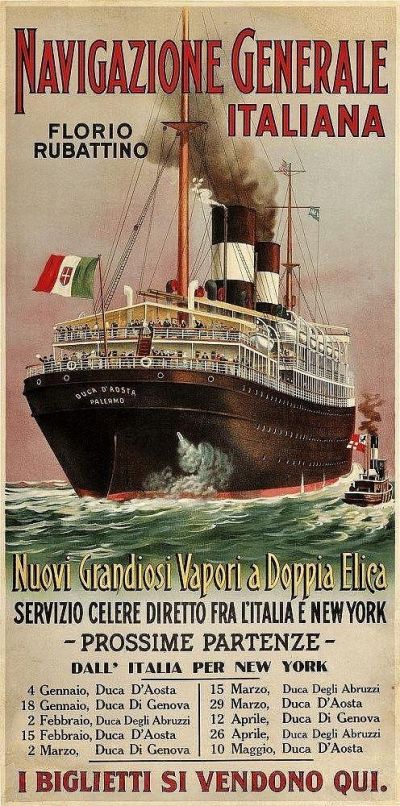Over the next few months, we are going to explore our Italian heritage from the perspective of our ancestors’ life experiences. This month our focus will be on how our ancestors arranged for passage to America.
Early on, many immigrants traveled on prepaid tickets purchased by their relatives who were already in America. Later, in many of the larger Italian villages, there were steam ship ticket brokers established as travel to America had become quite common and a lucrative business to be in. There were typically three classes of passenger travel for steam ships: first, second and third. Third was commonly known as steerage and most Italian immigrants sailed via steerage. By the 1900s, the typical steerage ticket cost between $25 and $30. This was a quite a sum of money for our ancestors to acquire, which is why it was quite common for a husband to come to America first, work for a few years to save enough money to then pay for the passage of his wife and children to join him in America.
For some, particularly the men, sometimes the ticket was paid for and provided by a padrone or via a “labor contract.” A padrone (boss) was a labor broker who acted as a middleman who brought men from Italy to America to supply labor to the owners of the mills, quarries, mines, and factories. The padrone would collect a fee from the employer for each laborer he supplied. In some instances, a padrone was an immigrant himself who had come to America earlier and learned how to become a labor broker. This padrone would help newcomers to America secure passage, with a promised job and housing waiting for them in America. In some cases, the padrone would loan funds to the new immigrant to help him get established and charge interest, sometimes at exorbitant rates. As you can imagine, some padroni were motivated by greed and did not always have the immigrants’ best interest in mind, using their naivete to exploit them. The immigrant would become very dependent upon the padrone. The padrone system became illegal in 1874 with the passage of the Padrone Act, however, it remained in existence until the 1930s.
As more and more young men emigrated to America, many young Italian women who had stayed behind, found themselves without any marriage prospects. Across the ocean in America there were young men who were of want of a “good Italian wife.” To rectify this situation, deals were made. Brothers who had already immigrated to America would broker deals with their friends or co-workers and arrange marriages for their single sisters back home. One story I was told about such an arrangement was quite interesting. An Italian gentleman in his forties was in the market for a wife. A neighbor had a maiden sister still living in Italy. The brother reached out to his sister via mail and asked her if she would consider marrying his friend who would pay for her passage to America. She agreed, but she wanted to see a photograph of her betrothed. A photograph was sent and after an affirmative reply, the ticket was purchased, and the young lady came to America. However, when she arrived and met her fiancé face-to-face, he was much older than the man in the photograph. The man had only one photograph of himself and it was taken when he was in his early twenties! The young woman felt that she had been swindled and refused to marry the man. In the end, a new bargain was reached. If the man would pay for the passage of her two maiden sisters still in Italy, she would marry him. He agreed, they married, and her sisters came to America. The couple went on to have eight children and stayed together until his death. By today’s standards, we may find these arrangements unusual, but they were more common than one would think. Romantic love was meant for people who were not hungry and poor. Leaving one’s country and family to travel across a vast ocean and to put your life into the hands of a stranger shows the amount of desperation these ladies must have faced to make such decisions so they too could experience the American dream.
For many of us, our ancestors may not have told us their story of how they came to America. But through examination of records and figuring out connections between individuals, you might be able to piece their story together. Start with their passenger list. Look at when each person came to America. Who did they travel with? Who is listed as having paid for their passage? Who were they joining in America? These entries will give you clues as to how a trip was funded and by who. Next month we will continue to explore the journey to America.



